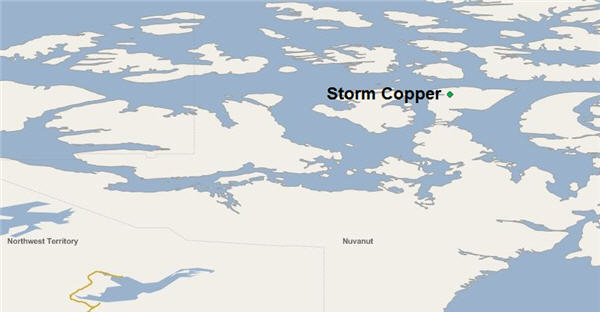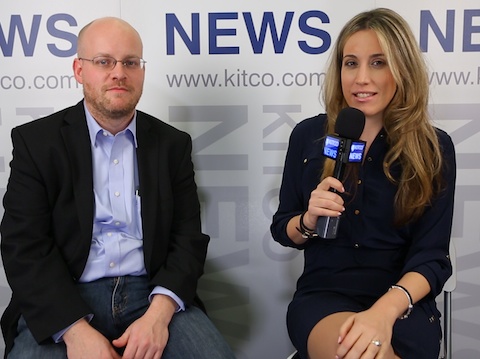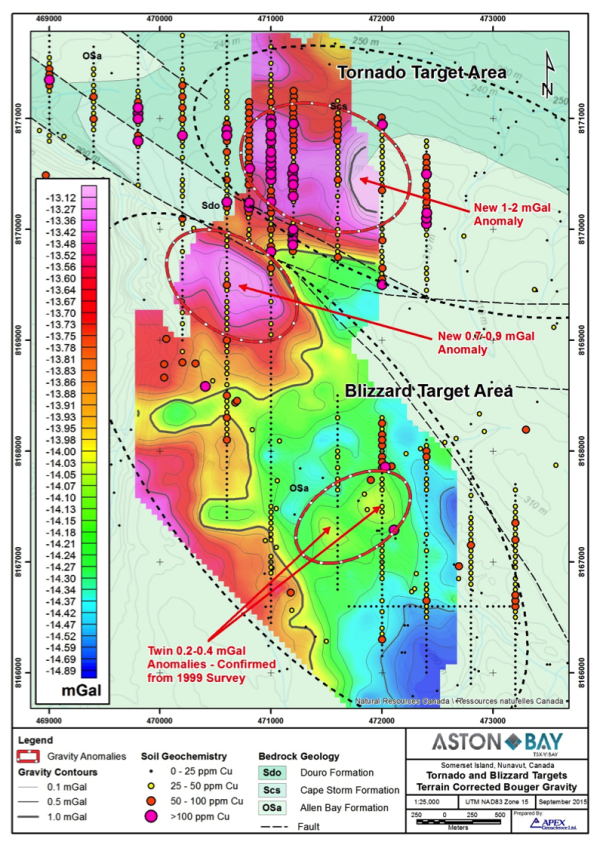The mining industry is experiencing its toughest bear market in decades and exploration companies are the hardest hit.
Aston Bay Holdings (BAY - TSXV), a tiny junior explorer looking for copper at the Storm project in Nunavut, Canada, hasn’t had more than six months worth of expenses in its treasury in more than four years.
The company had its moment in the sun in 2014 when it attracted an investment from major miner Antofagasta Plc (ANTO - LON). Antofagasta was going to drill-test Storm and carry Aston Bay to Feasibility plus two years in exchange for 70% of the asset.
Six weeks of falling copper prices later, Antofagasta withdrew from the joint venture and handed Storm back. At the time, Aston Bay CEO Benjamin Cox said the decision “in no way diminishes the technical merits of the project.”

Aston Bay Holdings Ltd. is a Canadian copper and zinc exploration company advancing the Storm Copper and Seal Zinc projects on Somerset Island, Nunavut. Map from Company & PropertyMine.
$BAY shares fell from over 40 cents to the mid-teens, and it was back to the drawing board for the company.
Cox himself is somewhat of an unusual character for a junior mining CEO. He is 37 years old and works in Vancouver, Washington, not the mining hub of Vancouver, Canada. Cox grew up in the resource development business. His father was a Calgary-based promoter in the 1980s who showed Benjamin the extreme ups and downs of exploration through that period.
Cox started a software non-profit in the dot-com days, straight out of university, and did well during the boom. His parents had an indirect stake in an iron ore exploration company, Roche Bay, and asked their son to be its President and CEO. He was 23.
Benjamin optioned the company’s flagship asset to another junior and was able to attract a state-owned Chinese steel company to advance it, but low iron ore prices ultimately curtailed its development. Earlier this year, Cox was let go from Roche Bay after 14 years.
Cox decided he wanted to be a hedge fund analyst in 2008, so he called up D.E. Shaw & Co. in Manhattan and pitched them on the idea of vetting commodity investments. While at D.E. Shaw, Cox surveyed commodity supply and demand balances. His experience there helped him determine that copper had the brightest future of all metals. Cox, who is known for making blunt observations, says he did not have the social skills required for the hedge fund world. He left D.E. Shaw after 2 years to return to the mining business.
In 2010, Cox created a financial data company called www.oreninc.com to “organize every copper asset in the world.” Of hundreds of global copper exploration projects, Cox set his sights on Commander Resources’ Storm asset in Nunavut - Canada’s far North - for a few reasons.
He was attracted to Storm because of previous high-grade drill results over sizable intersections (the best historical hole was 110 metres of 2.45% copper) that had not been adequately followed up on. Cox and his team think Storm is a system, not just a random deposit with nothing around it. The project is close to tidewater, making access somewhat easier.
Cox’s Aston Bay struck a deal to earn a 50% interest in Storm by spending $6 million in exploration by 2018, and 70% by spending $15 million. Aston can buy Commander out for 20% of its market cap or $15 million, whichever is greater, after the earn-in is complete.
Roughly $3.5 million has been invested to date by Aston Bay in Storm, Cox says. This includes licensing historical data, doing field work, re-assaying drill core as well as gravity surveys.
This morning, Aston Bay announced that the summer’s gravity survey at Storm had identified two drill targets with kilometre-scale potential.
Here is a link to this morning’s news release: Aston Bay Identifies Two High-Priority Drill Targets from the 2015 Gravity Surveys at Storm
Cox thinks the gravity targets are legit because they correspond with copper soil anomalies as well as a zone of conductivity from a 2011 VTEM survey. Gravity surveys help remove some of the false positive VTEM possibilities, such as graphite and salt water.
Cox says the summer developments show that Aston Bay is serious about exploration. He credits the advice of John Hayes, a retired Managing Director at BMO Capital Markets who is on Aston Bay’s advisory board. Management thinks the Storm copper project is among the most compelling copper exploration projects in the world outside of the African copper belt.
Aston Bay wants to expand its gravity survey at Storm next spring, and Cox would like to drill 2,500-3,000 metres next summer. Together, these activities would require a roughly $3-4 million budget - money Aston Bay doesn’t currently have.
Cox says he is focused on raising equity within Aston Bay to advance the asset alone, as well as looking at potential Storm partners.
Add Aston Bay - symbol $BAY.v - to your watch list and meet Cox in chat.ceo.ca - the investment conference in your pocket.























